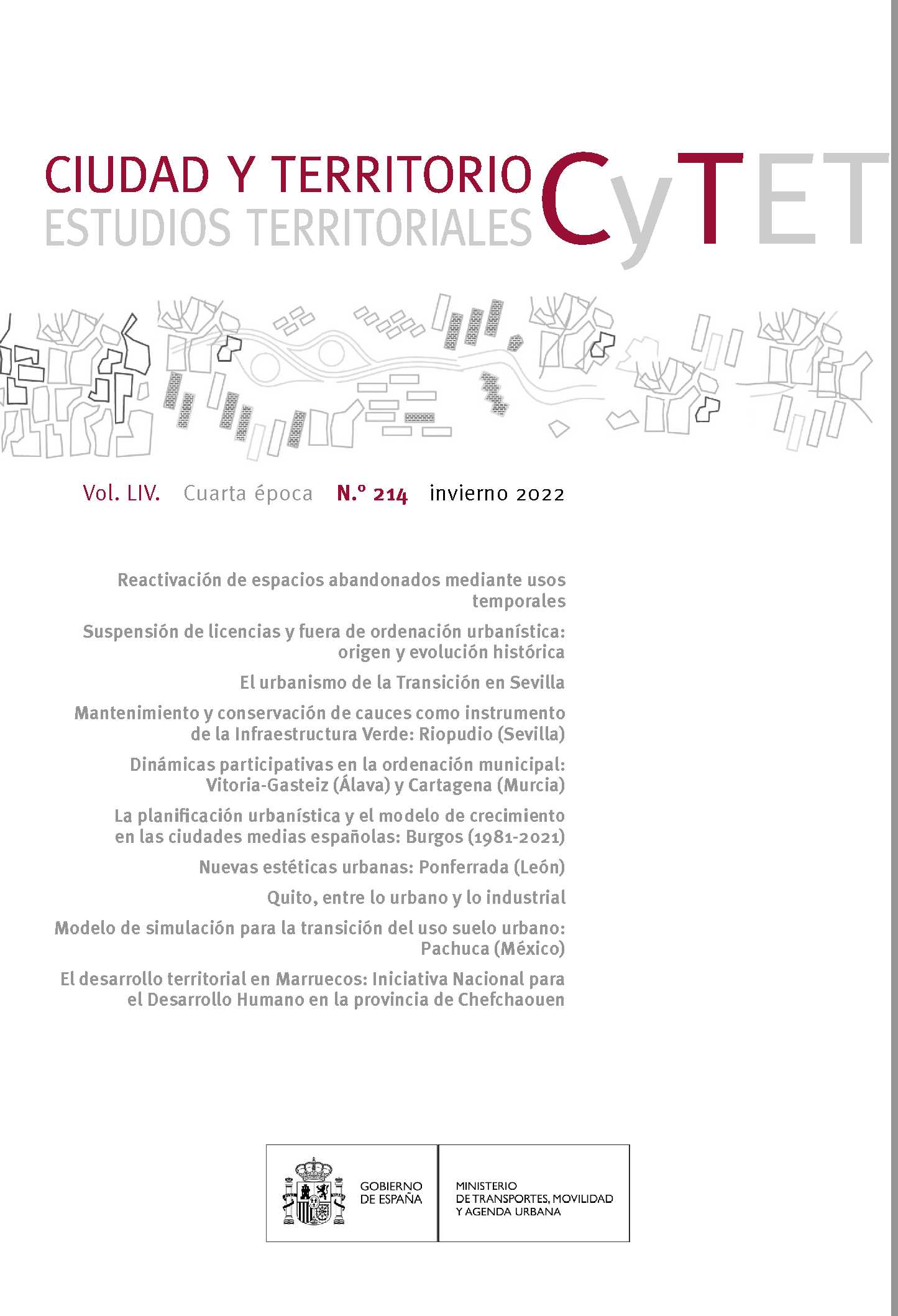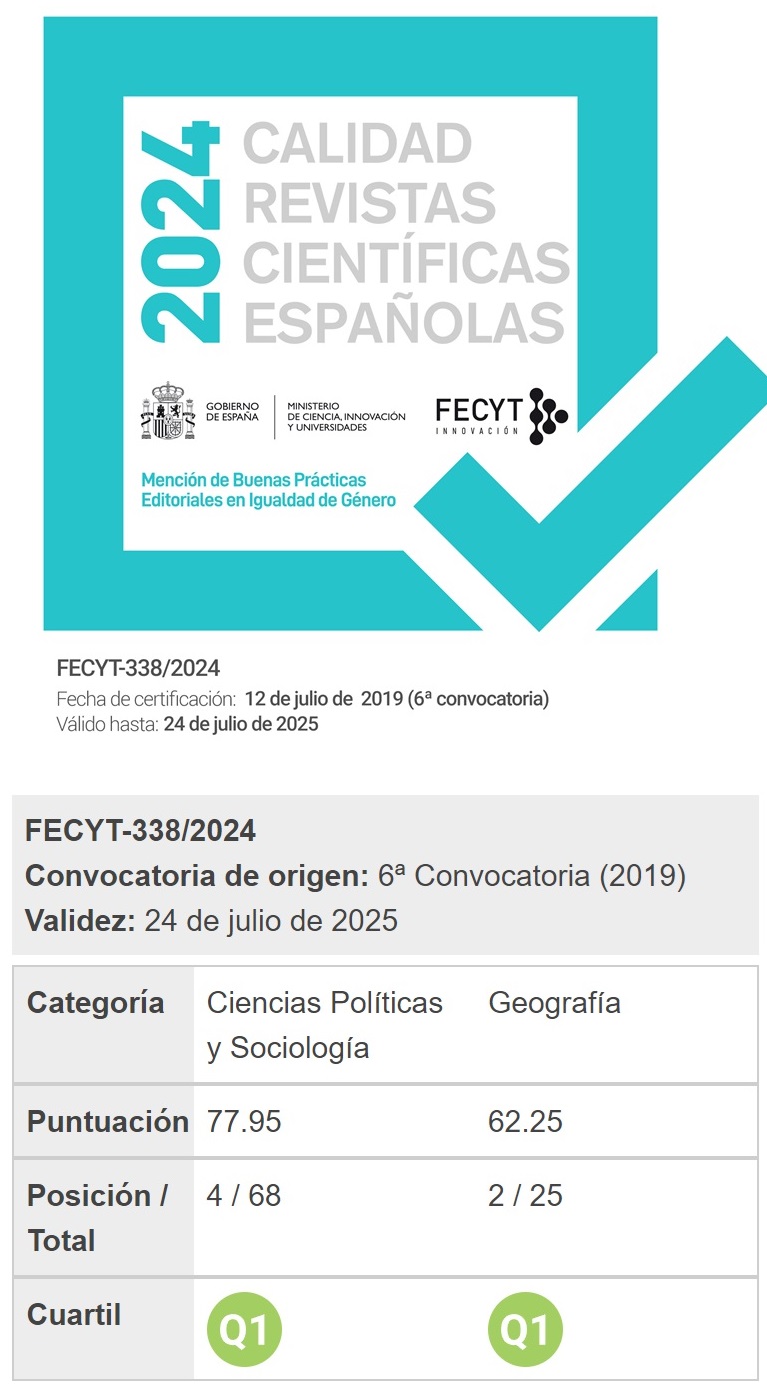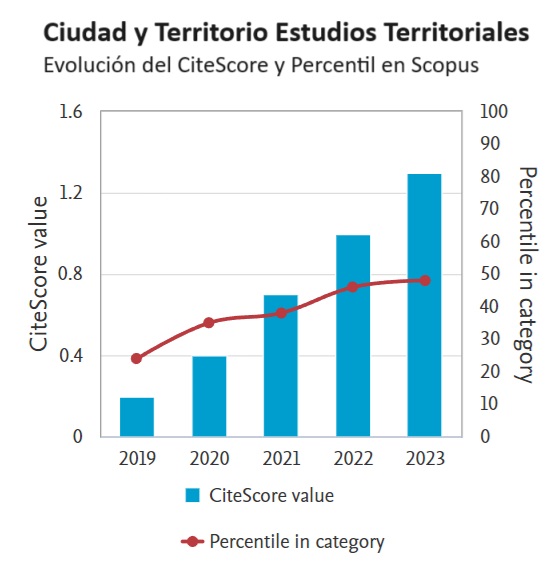Nuevas estéticas urbanas: el lavado de cara de Ponferrada
DOI:
https://doi.org/10.37230/CyTET.2022.214.7Palabras clave:
Ciudad sostenible, Urbanismo, Geografía urbana, Renovación urbanaResumen
En las últimas décadas la intensidad de la transformación urbana en España ha provocado que, en algunos casos, se haya producido un cambio radical en la percepción colectiva que existe de su imagen como ciudad. Este es el caso de Ponferrada que presenta una morfología condicionada por las actividades productivas asociadas al carbón y a la producción eléctrica. Estas actividades, que generaron el máximo esplendor económico de la ciudad y de su comarca, también provocaron importantes problemas y disfuncionalidades, especialmente en el ámbito urbanístico, en el social y en el medioambiental. Hoy en día, la ciudad ha superado la etapa de su historia en la que sus habitantes sufrían la ciudad. Esta situación se ha revertido, en su mayor parte, gracias a la puesta en marcha de numerosas medidas e iniciativas, más próximas a los nuevos paradigmas imperantes en la actualidad sobre lo que entendemos por una ciudad del siglo XXI.
Descargas
Citas
Alonso, J.L. (1984): El proceso urbano de Ponferrada, Salamanca, España, Gráficas Alonso.
Alonso, J.L. (2004): Ponferrada: práctica urbana y liberación de los terrenos de la industria minera. ¿De la fragmentación física a la social? Ería, (63),35-52.
Alonso, J.L. (2011): Planificación y práctica urbana en la ciudad de Ponferrada: El PGOU 2007. Ciudad Y Territorio. Estudios Territoriales, (167), 131-151.
Ayuntamiento de Ponferrada (1989): Normas Urbanísticas, PGOU.
Benito, P. (2010): Industria y patrimonialización del paisaje urbano: la reutilización de las viejas fábricas. En C. Cornejo & J. Morán & J. Prada (Coords.), Ciudad, territorio y paisaje: reflexiones para un debate multidisciplinar (pp. 354-366), Madrid, España, Compañía Española de Reprografía.
Benito, P. & López A. (2008): Patrimonio industrial y nuevas perspectivas funcionales para las ciudades en reestructuración. Estudios Geográficos, 69(264), 23-50.
Courel, J.A. & del Reguero, V. (2018): El tiempo de la minero, Meres, España, Piélago del Moro Ediciones.
Fernández, M. & Fernández, A. & Fernández, G. & Fernández, J.R. (2010): El sistema de regadío en El Bierzo. Ería, (82), 159-169.
González, M.J. (2006): La Sostenibilidad de los Centros Históricos en los Albores del Siglo XXI. Anales de Geografía, (26), 49-63.
Juaristi, J. (2000): Sistemas urbanos y ciudades medias en el arco Atlántico. En C. Bellet & J.M. Llop (eds.), Ciudades intermedias: Urbanización y sostenibilidad (pp. 143-167), Lérida, España, Ed. Milenio.
Larrinaga, C. (2011): Regeneración urbanística y nuevas opciones turísticas de las ciudades post-industriales: el caso de Bilbao. TsT: Transportes, Servicios y Telecomunicaciones, (21), 53-86.
López-Trigal, L. (1989): Los problemas urbanos en las ciudades leonesas. Estudios Geográficos, (196), 381-407.
Moreno, S. & González, F.J. & Gómez, A. (2014): La regeneración urbana en España: Revisión crítica para un estudio de caso de regeneración sostenible. Revista de Arquitectura, 19(27), 6-14.
Pellicer, F. & Barrao, S. & López-Álverez, M. (2021): Estrategia integrada para la recuperación de tramos fluviales urbanos. El caso del río Piles en Gijón compatible con usos deportivos. Geographycalia, (73), 213-242.
Pérez, A. & González, V. (1996): Álbum del Bierzo, Salamanca, España, Junta de Castilla y León.
Relea, C.E. (2002a): Ponferrada y el río Sil: el reencuentro de una ciudad con su origen. En L. López-Trigal & C.E. Relea & J. Somoza (coords.), La ciudad: nuevos procesos, nuevas respuestas, Actas del VI Coloquio de Geografía Urbana (pp. 287-295), León, España, Universidad de León.
Relea, C.E. (2002b): Estructura y procesos urbanos en la ciudad de Ponferrada (1984-2002) [Trabajo de investigación inédito], León, España, Universidad de León.
Rueda, S. (2012): Libro Verde de Sostenibilidad Urbana y Local en la Era de la Información, Madrid, España, Ministerio de Agricultura, Alimentación y Medio Ambiente.
Ruano, M. (2000): Ecourbanos. Entornos urbanos sostenibles: 60 proyectos. Barcelona, España, Editorial Gustavo Gili S.A.
Ruano, M. (dir.) (s.f.): Certificación del urbanismo ecológico. Ministerio de Fomento y Agencia de Ecología Urbana de Barcelona. http://www.bcnecologia.net/sites/default/files/publicaciones/docs/certificacion_del_urbanismo_ecologico.pdf
Suárez, J. & Vilanova, A. (2013): La rehabilitación del conjunto de la central térmica de la MSP en Ponferrada (León): reconocimiento de los valores patrimoniales de un paisaje industrial singular. LIÑO, Revista Anual de Historia del Arte, (19), 123-131.
Tomé, S. (1997): León, los ríos en el paisaje urbano, Oviedo, España, Universidad de Oviedo.
Tomé, S. (2002): Ponferrada: las ciudades en reconversión minera. Ería, (57), 79-90.
Tomé, S. (2010): Langreo, Mieres, Ponferrada, Puertollano: cambios funcionales y morfológicos en ciudades minero industriales. Scripta Nova, 14(336). http://www.ub.edu/geocrit/sn/sn-336.htm
Troitiño, M.A. (1998): Turismo y desarrollo sostenible en ciudades históricas. Ería, (47), 211-227.
Uriarte, P. (1997): Problemas y soluciones del planeamiento urbano de Ponferrada. En L. López-Trigal (Dir.), El planeamiento urbano y estratégico, II Jornadas de Estudios y Debate Urbanos (pp.247-258), León, España, Universidad de León.
Publicado
Cómo citar
Número
Sección
Licencia
Derechos de autor 2022 CARLOS EMILIO RELEA FERNANDEZ

Esta obra está bajo una licencia internacional Creative Commons Atribución-NoComercial-SinDerivadas 4.0.
Sin perjuicio de lo dispuesto en la legislación vigente sobre Propiedad Intelectual, y conforme a la misma, el/la los/las autor/a/es/as que publiquen en CyTET cede/n a título gratuito, de modo no exclusivo y sin límite temporal al Ministerio de Transportes, Movilidad y Agenda Urbana los derechos para difundir, reproducir, comunicar y distribuir en cualquier formato actual o futuro, en papel o electrónico, la versión original o derivada de su obra bajo licencia de Creative Commons Reconocimiento-NoComercial-SinObraDerivada 4.0 Internacional (CC BY-NC-ND 4.0), así como para incluir o ceder a terceros la inclusión de su contenido en índices, repositorios y bases de datos nacionales e internacionales, con referencia y reconocimiento en todo caso de la autoría del mismo.
Además, al realizar el envío, el/la los/las autor/a/es/as declara/n que se trata de un trabajo original en el que se reconocen las fuentes que han sido utilizadas en su estudio, comprometiéndose a respetar la evidencia científica y a no modificar los datos originales para verificar o refutar una hipótesis de partida; que el contenido esencial del mismo no ha sido publicado previamente ni se publicará en ninguna otra obra o revista mientras esté en proceso de evaluación en la revista CyTET; y que no se ha remitido simultáneamente a otra publicación.
Los autores deben firmar un Formulario de Cesión de Derechos, que les será enviado desde la Secretaría de CyTET una vez se acepte su artículo para ser publicado.
Con el objetivo de favorecer la difusión del conocimiento, CyTET se adhiere al movimiento de revistas de Open Access (OA) y entrega la totalidad de sus contenidos a diversos índices, repositorios y bases de datos nacionales e internacionales bajo este protocolo; por tanto, la remisión de un trabajo para ser publicado en la revista presupone la aceptación explícita por parte del autor/a de este método de distribución.
Se anima a las/os autoras/es a reproducir y alojar sus trabajos publicados en CyTET en repositorios institucionales, páginas web, etc. con la intención de contribuir a la mejora de la transferencia del conocimiento y de la citación de dichos trabajos.








 Enlace a CyTET en Linkedin
Enlace a CyTET en Linkedin